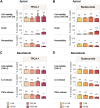Development of an Advanced Multicellular Intestinal Model for Assessing Immunomodulatory Properties of Anti-Inflammatory Compounds
- PMID: 33935729
- PMCID: PMC8085553
- DOI: 10.3389/fphar.2021.639716
Development of an Advanced Multicellular Intestinal Model for Assessing Immunomodulatory Properties of Anti-Inflammatory Compounds
Abstract
Intestinal inflammation is the collective term for immune system-mediated diseases of unknown, multifactorial etiology, with often complex interactions between genetic and environmental factors. To mechanistically investigate the effect of treatment with compounds possessing immunomodulating properties in the context of intestinal inflammation, we developed an immunocompetent in vitro triculture intestinal model consisting of a differentiated intestinal epithelial layer (Caco-2/HT29-MTX) and immunocompetent cells (differentiated THP-1). The triculture mimicked a healthy intestine with stable barrier integrity. Lipopolysaccharide treatment triggered a controlled and reversible inflammatory state, resulting in significant impairment of barrier integrity and release of pro-inflammatory cytokines and chemokines, which are known hallmarks of intestinal inflammation. Treatment with known anti-inflammatory reference compounds (TPCA-1 and budenoside) prevented the induction of an inflammatory state; the decreasing triculture responses to this treatment measured by cytokine release, transepithelial electric resistance (TEER), and epithelial layer permeability proved the suitability of the intestinal model for anti-inflammatory drug screening. Finally, selected tobacco alkaloids (nicotine and anatabine (R/S and S forms)) were tested in the in vitro triculture for their potential anti-inflammatory properties. Indeed, naturally occurring alkaloids, such as tobacco-derived alkaloids, have shown substantial anti-inflammatory effects in several in vitro and in vivo models of inflammation, gaining increasing interest. Similar to the anti-inflammatory reference compounds, one of the tobacco alkaloids under investigation partially prevented the decrease in the TEER and increase in permeability and reduced the release of pro-inflammatory cytokines and chemokines. Taken together, these data confirm that our in vitro model is suitable for screening potential anti-inflammatory compounds in the context of intestinal inflammation.
Keywords: anatabine; immune competent cells; in vitro co-culture; inflamed intestine; inflammatory bowel disease; intestinal inflammation; nicotine; tobacco alkaloids.
Copyright © 2021 Marescotti, Lo Sasso, Guerrera, Renggli, Ruiz Castro, Piault, Jaquet, Moine, Luettich, Frentzel, Peitsch and Hoeng.
Conflict of interest statement
All authors are employees of Philip Morris International R&D or had worked for Philip Morris International R&D under contractual agreements.
Figures






Similar articles
-
Development of an Inflammation-Triggered In Vitro "Leaky Gut" Model Using Caco-2/HT29-MTX-E12 Combined with Macrophage-like THP-1 Cells or Primary Human-Derived Macrophages.Int J Mol Sci. 2023 Apr 18;24(8):7427. doi: 10.3390/ijms24087427. Int J Mol Sci. 2023. PMID: 37108590 Free PMC article.
-
Anatabine ameliorates intestinal inflammation and reduces the production of pro-inflammatory factors in a dextran sulfate sodium mouse model of colitis.J Inflamm (Lond). 2020 Aug 24;17:29. doi: 10.1186/s12950-020-00260-6. eCollection 2020. J Inflamm (Lond). 2020. PMID: 32855621 Free PMC article.
-
An Intestine-on-a-Chip Model of Plug-and-Play Modularity to Study Inflammatory Processes.SLAS Technol. 2020 Dec;25(6):585-597. doi: 10.1177/2472630320924999. Epub 2020 Jun 24. SLAS Technol. 2020. PMID: 32576063 Free PMC article.
-
A three-dimensional coculture of enterocytes, monocytes and dendritic cells to model inflamed intestinal mucosa in vitro.Mol Pharm. 2010 Dec 6;7(6):2103-19. doi: 10.1021/mp1000795. Epub 2010 Nov 1. Mol Pharm. 2010. PMID: 20809575
-
Development, validation and implementation of an in vitro model for the study of metabolic and immune function in normal and inflamed human colonic epithelium.Dan Med J. 2015 Jan;62(1):B4973. Dan Med J. 2015. PMID: 25557335 Review.
Cited by
-
Optimizing THP-1 Macrophage Culture for an Immune-Responsive Human Intestinal Model.Cells. 2023 May 19;12(10):1427. doi: 10.3390/cells12101427. Cells. 2023. PMID: 37408263 Free PMC article.
-
Nicotine in Inflammatory Diseases: Anti-Inflammatory and Pro-Inflammatory Effects.Front Immunol. 2022 Feb 18;13:826889. doi: 10.3389/fimmu.2022.826889. eCollection 2022. Front Immunol. 2022. PMID: 35251010 Free PMC article. Review.
-
Development and assessment of an intestinal tri-cellular model to investigate the pro/anti-inflammatory potential of digested foods.Front Immunol. 2025 Feb 5;16:1545261. doi: 10.3389/fimmu.2025.1545261. eCollection 2025. Front Immunol. 2025. PMID: 39975553 Free PMC article.
-
Elevated risk of adverse effects from foodborne contaminants and drugs in inflammatory bowel disease: a review.Arch Toxicol. 2024 Nov;98(11):3519-3541. doi: 10.1007/s00204-024-03844-w. Epub 2024 Sep 9. Arch Toxicol. 2024. PMID: 39249550 Free PMC article. Review.
-
Leveraging Organ-on-Chip Models to Investigate Host-Microbiota Dynamics and Targeted Therapies for Inflammatory Bowel Disease.Adv Healthc Mater. 2025 Apr;14(10):e2402756. doi: 10.1002/adhm.202402756. Epub 2024 Nov 3. Adv Healthc Mater. 2025. PMID: 39491534 Free PMC article. Review.
References
-
- Abreu M. T., Vora P., Faure E., Thomas L. S., Arnold E. T., Arditi M. (2001). Decreased Expression of Toll-like Receptor-4 and MD-2 Correlates with Intestinal Epithelial Cell Protection against Dysregulated Proinflammatory Gene Expression in Response to Bacterial Lipopolysaccharide. J. Immunol. 167 (3), 1609–1616. 10.4049/jimmunol.167.3.1609 - DOI - PubMed
-
- Alijevic O., McHugh D., Rufener L., Mazurov A., Hoeng J., Peitsch M. (2020). An Electrophysiological Characterization of Naturally Occurring Tobacco Alkaloids and Their Action on Human α4β2 and α7 Nicotinic Acetylcholine Receptors. Phytochemistry 170, 112187. 10.1016/j.phytochem.2019.112187 - DOI - PubMed
LinkOut - more resources
Full Text Sources
Other Literature Sources

